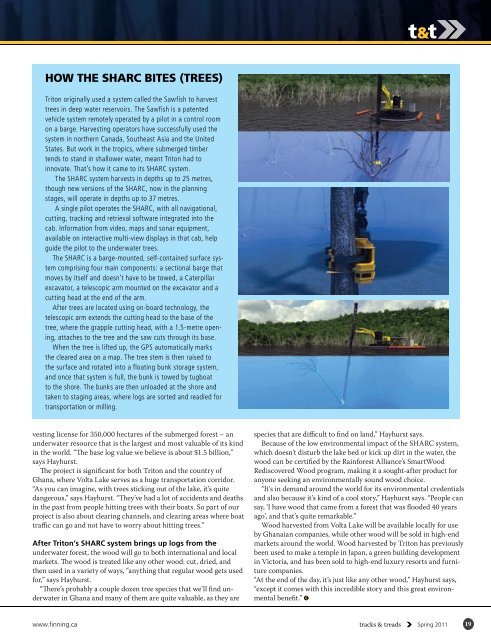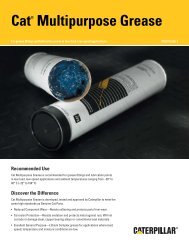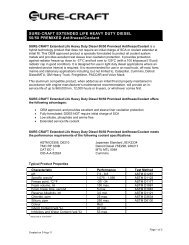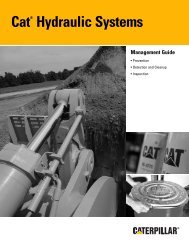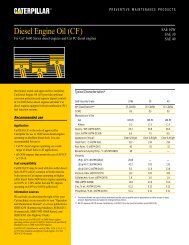Water: Logged Ply the River Company Secret - Finning Canada
Water: Logged Ply the River Company Secret - Finning Canada
Water: Logged Ply the River Company Secret - Finning Canada
You also want an ePaper? Increase the reach of your titles
YUMPU automatically turns print PDFs into web optimized ePapers that Google loves.
HOW THE SHARC BITES (TREES)Triton originally used a system called <strong>the</strong> Sawfish to harvesttrees in deep water reservoirs. The Sawfish is a patentedvehicle system remotely operated by a pilot in a control roomon a barge. Harvesting operators have successfully used <strong>the</strong>system in nor<strong>the</strong>rn <strong>Canada</strong>, Sou<strong>the</strong>ast Asia and <strong>the</strong> UnitedStates. But work in <strong>the</strong> tropics, where submerged timbertends to stand in shallower water, meant Triton had toinnovate. That’s how it came to its SHARC system.The SHARC system harvests in depths up to 25 metres,though new versions of <strong>the</strong> SHARC, now in <strong>the</strong> planningstages, will operate in depths up to 37 metres.A single pilot operates <strong>the</strong> SHARC, with all navigational,cutting, tracking and retrieval software integrated into <strong>the</strong>cab. Information from video, maps and sonar equipment,available on interactive multi-view displays in that cab, helpguide <strong>the</strong> pilot to <strong>the</strong> underwater trees.The SHARC is a barge-mounted, self-contained surface systemcomprising four main components: a sectional barge thatmoves by itself and doesn’t have to be towed, a Caterpillarexcavator, a telescopic arm mounted on <strong>the</strong> excavator and acutting head at <strong>the</strong> end of <strong>the</strong> arm.After trees are located using on-board technology, <strong>the</strong>telescopic arm extends <strong>the</strong> cutting head to <strong>the</strong> base of <strong>the</strong>tree, where <strong>the</strong> grapple cutting head, with a 1.5-metre opening,attaches to <strong>the</strong> tree and <strong>the</strong> saw cuts through its base.When <strong>the</strong> tree is lifted up, <strong>the</strong> GPS automatically marks<strong>the</strong> cleared area on a map. The tree stem is <strong>the</strong>n raised to<strong>the</strong> surface and rotated into a floating bunk storage system,and once that system is full, <strong>the</strong> bunk is towed by tugboatto <strong>the</strong> shore. The bunks are <strong>the</strong>n unloaded at <strong>the</strong> shore andtaken to staging areas, where logs are sorted and readied fortransportation or milling.vesting license for 350,000 hectares of <strong>the</strong> submerged forest – anunderwater resource that is <strong>the</strong> largest and most valuable of its kindin <strong>the</strong> world. “The base log value we believe is about $1.5 billion,”says Hayhurst.The project is significant for both Triton and <strong>the</strong> country ofGhana, where Volta Lake serves as a huge transportation corridor.“As you can imagine, with trees sticking out of <strong>the</strong> lake, it’s quitedangerous,” says Hayhurst. “They’ve had a lot of accidents and deathsin <strong>the</strong> past from people hitting trees with <strong>the</strong>ir boats. So part of ourproject is also about clearing channels, and clearing areas where boattraffic can go and not have to worry about hitting trees.”After Triton’s SHARC system brings up logs from <strong>the</strong>underwater forest, <strong>the</strong> wood will go to both international and localmarkets. The wood is treated like any o<strong>the</strong>r wood: cut, dried, and<strong>the</strong>n used in a variety of ways, “anything that regular wood gets usedfor,” says Hayhurst.“There’s probably a couple dozen tree species that we’ll find underwaterin Ghana and many of <strong>the</strong>m are quite valuable, as <strong>the</strong>y arespecies that are difficult to find on land,” Hayhurst says.Because of <strong>the</strong> low environmental impact of <strong>the</strong> SHARC system,which doesn’t disturb <strong>the</strong> lake bed or kick up dirt in <strong>the</strong> water, <strong>the</strong>wood can be certified by <strong>the</strong> Rainforest Alliance’s SmartWoodRediscovered Wood program, making it a sought-after product foranyone seeking an environmentally sound wood choice.“It’s in demand around <strong>the</strong> world for its environmental credentialsand also because it’s kind of a cool story,” Hayhurst says. “People cansay, ‘I have wood that came from a forest that was flooded 40 yearsago’, and that’s quite remarkable.”Wood harvested from Volta Lake will be available locally for useby Ghanaian companies, while o<strong>the</strong>r wood will be sold in high-endmarkets around <strong>the</strong> world. Wood harvested by Triton has previouslybeen used to make a temple in Japan, a green building developmentin Victoria, and has been sold to high-end luxury resorts and furniturecompanies.“At <strong>the</strong> end of <strong>the</strong> day, it’s just like any o<strong>the</strong>r wood,” Hayhurst says,“except it comes with this incredible story and this great environmentalbenefit.”www.finning.ca tracks & treads Spring 2011 19


